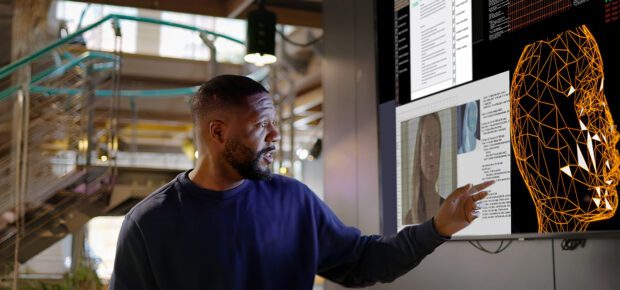December 4, 2024
If you’ve heard of deepfakes, the highly realistic videos of people doing things they’ve never done, or saying things they’ve never said, you may think they are a dubious technological development. They’ve been used to impersonate executives in advanced phishing scams in which fake voicemails are used to request urgent funds from employees. And they’ve been at the center of other controversies that damage reputations and cause real harm.
Their very existence has set off a flood of research into ways to identify them.
But deepfakes aren’t all bad. In fact, they can be used for good.
They could allow executives of global businesses to deliver messages to employees in their native language, translating speeches in real-time with lip movement to match the words as they are spoken. They are used to create realistic simulations for workforce development or to bring historical figures to life to make complex topics more relatable in schools.
Why Researchers Need ‘Good’ Deepfakes
The medical field is one of the biggest users of helpful deepfakes. These deepfakes are often used to create extra training data for machine learning programs. For example, when researchers train artificial intelligence (AI) to detect certain types of cancer in medical images like MRIs or X-rays, they might use deepfakes to add more images to their datasets.
This is necessary because many datasets are small or incomplete. Training AI models requires painstaking attention to detail, with lots of human intervention to label certain features of a dataset. Sometimes, scans aren’t labeled correctly or the labels are inconsistent because different people used different criteria. These issues can make it harder for AI models to learn accurately. Generating synthetic data can help overcome these challenges, though the quality of the synthetic data must also be carefully monitored.
It’s Becoming Easier to Make a Deepfake
“While the technology to create deepfakes has become more accessible over the years, it still requires a certain level of expertise,” said IEEE Senior Member Vivekanandhan Muthulingam.
“There are user-friendly tools and applications available that allow individuals to experiment with deepfake creation without extensive programming knowledge,” Muthulingam said. “However, achieving high-quality results still necessitates a deeper understanding of machine learning principles and video editing.”
Those making these deepfakes also need to understand the underlying subject matter as well.
“To create ‘good’ deepfakes, both AI and domain knowledge are required,” said IEEE Fellow Houbing Song.
Ethical Considerations
Experts warn that ethical responsibilities don’t go away just because deepfakes are created for a good cause. Using them responsibly means being honest and putting protections in place to support learning and innovation without risking trust or safety. There may also be ethical considerations regarding training data, which may be subject to copyright or intellectual property claims, or because of concerns over using patient information for training data.
There may also be grey areas in which the value of deepfakes isn’t clear cut.
“Whether a deepfake is good or not will be judged by how well their benefits align with societal expectations,” Song said. “In the long run, if we put deepfakes to good use, the benefits of deepfakes will outweigh the risks.”
Learn more: For an in-depth look at how researchers use machine learning to create synthetic data in medical images, check out this article from IEEE.





 The Impact of Technology in 2025
The Impact of Technology in 2025 Quantum and AI: Safeguards or Threats to Cybersecurity?
Quantum and AI: Safeguards or Threats to Cybersecurity? Why AI Can't Live Without Us
Why AI Can't Live Without Us Bits, Bytes, Buildings and Bridges: Digital-Driven Infrastructure
Bits, Bytes, Buildings and Bridges: Digital-Driven Infrastructure Impact of Technology in 2024
Impact of Technology in 2024 Emerging AI Cybersecurity Challenges and Solutions
Emerging AI Cybersecurity Challenges and Solutions The Skies are Unlimited
The Skies are Unlimited Smart Cities 2030: How Tech is Reshaping Urbanscapes
Smart Cities 2030: How Tech is Reshaping Urbanscapes Impact of Technology 2023
Impact of Technology 2023 Cybersecurity for Life-Changing Innovations
Cybersecurity for Life-Changing Innovations Smarter Wearables Healthier Life
Smarter Wearables Healthier Life Infrastructure In Motion
Infrastructure In Motion The Impact of Tech in 2022 and Beyond
The Impact of Tech in 2022 and Beyond Cybersecurity, Technology and Protecting Our World
Cybersecurity, Technology and Protecting Our World How Technology Helps us Understand Our Health and Wellness
How Technology Helps us Understand Our Health and Wellness The Resilience of Humanity
The Resilience of Humanity Harnessing and Sustaining our Natural Resources
Harnessing and Sustaining our Natural Resources Creating Healthy Spaces Through Technology
Creating Healthy Spaces Through Technology Exceptional Infrastructure Challenges, Technology and Humanity
Exceptional Infrastructure Challenges, Technology and Humanity The Global Impact of IEEE's 802 Standards
The Global Impact of IEEE's 802 Standards Scenes of our Cyber Lives: The Security Threats and Technology Solutions Protecting Us
Scenes of our Cyber Lives: The Security Threats and Technology Solutions Protecting Us How Millennial Parents are Embracing Health and Wellness Technologies for Their Generation Alpha Kids
How Millennial Parents are Embracing Health and Wellness Technologies for Their Generation Alpha Kids Space Exploration, Technology and Our Lives
Space Exploration, Technology and Our Lives Global Innovation and the Environment
Global Innovation and the Environment How Technology, Privacy and Security are Changing Each Other (And Us)
How Technology, Privacy and Security are Changing Each Other (And Us) Find us in booth 31506, LVCC South Hall 3 and experience the Technology Moon Walk
Find us in booth 31506, LVCC South Hall 3 and experience the Technology Moon Walk Virtual and Mixed Reality
Virtual and Mixed Reality How Robots are Improving our Health
How Robots are Improving our Health IEEE Experts and the Robots They are Teaching
IEEE Experts and the Robots They are Teaching See how millennial parents around the world see AI impacting the lives of their tech-infused offspring
See how millennial parents around the world see AI impacting the lives of their tech-infused offspring Take the journey from farm to table and learn how IoT will help us reach the rising demand for food production
Take the journey from farm to table and learn how IoT will help us reach the rising demand for food production Watch technical experts discuss the latest cyber threats
Watch technical experts discuss the latest cyber threats Explore how researchers, teachers, explorers, healthcare and medical professionals use immersive technologies
Explore how researchers, teachers, explorers, healthcare and medical professionals use immersive technologies Follow the timeline to see how Generation AI will be impacted by technology
Follow the timeline to see how Generation AI will be impacted by technology Learn how your IoT data can be used by experiencing a day in a connected life
Learn how your IoT data can be used by experiencing a day in a connected life Listen to technical experts discuss the biggest security threats today
Listen to technical experts discuss the biggest security threats today See how tech has influenced and evolved with the Games
See how tech has influenced and evolved with the Games Enter our virtual home to explore the IoT (Internet of Things) technologies
Enter our virtual home to explore the IoT (Internet of Things) technologies Explore an interactive map showcasing exciting innovations in robotics
Explore an interactive map showcasing exciting innovations in robotics Interactively explore A.I. in recent Hollywood movies
Interactively explore A.I. in recent Hollywood movies Get immersed in technologies that will improve patients' lives
Get immersed in technologies that will improve patients' lives